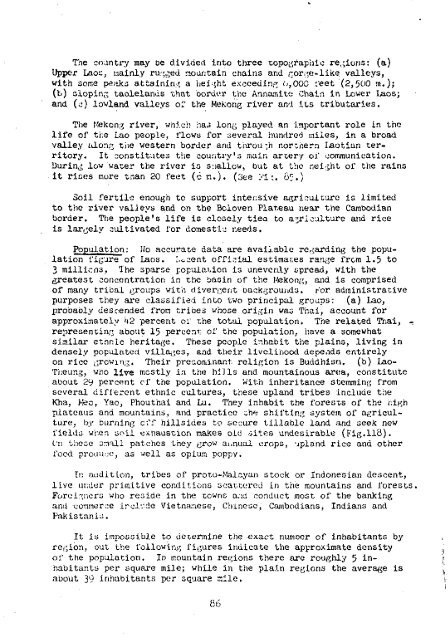Vegetation of Southeast Asia Studies of Forest Types 1963-1965
Vegetation of Southeast Asia Studies of Forest Types 1963-1965
Vegetation of Southeast Asia Studies of Forest Types 1963-1965
Create successful ePaper yourself
Turn your PDF publications into a flip-book with our unique Google optimized e-Paper software.
The country may be divided into three topographic regions: (a)<br />
Upper Laoc, mainly ru.^ed mountain chains arid /~or^e-like valleys,<br />
with some pe.-iks attaining a height exceeding u,OOC feet (2,500 rn.);<br />
(b) sloping taolelands that border the Annamite Chain in Lower Laos;<br />
and (c) lowland valleys <strong>of</strong> the Mekong river and its tributaries.<br />
The Mekong river, which has lon^ played an important role in the<br />
life <strong>of</strong> the Lao people, flows for several hundred miles, in a broad<br />
valley along the western border and throu ^h northern I/aotian territory.<br />
It constitutes the country's main artery <strong>of</strong> communication.<br />
During low water the river is shallow, but at the nei ; ;ht <strong>of</strong> the rains<br />
it rices more tnan 20 feet (6 m.). (3ee I'!;. 0.}<br />
Soil fertile enough to support intensive agriculture is limited<br />
to the river valleys and on the Boloven Plateau near the Cambodian<br />
border. The people's life is closely tiea to agriculture and rice<br />
is largely cultivated for domestic needs.<br />
Population: No accurate data are available regarding the population<br />
figure <strong>of</strong> Laos. Lucent <strong>of</strong>ficial estimar.es ran^e from 1.5 to<br />
3 millions. The sparse copulation is unevenly spread, with the<br />
greatest concentration in the basin <strong>of</strong> the Mekong, and is comprised<br />
<strong>of</strong> many tribal groups with d.ivercent backgrounds, r'or administrative<br />
purposes they are classified into two principal groups: (a) Lao,<br />
probably descended from tribes whose origin way Thai, account for<br />
approximately 42 percent <strong>of</strong> the total population. The related Thai, .<br />
representing about 15 percent <strong>of</strong> the population, have a somewhat<br />
similar ethnic heritage. These people inhabit the plains, living in<br />
densely populated villages, and their livelihood depends entirely<br />
on rice growing. Their predominant, religion is Buddhisn. (b) Lao-<br />
Theung, who live mostly in the hiJls and mountainous area, constitute<br />
about 29 percent <strong>of</strong> the population. With inheritance stemming from<br />
several different ethnic cultures, these upland tribes include the<br />
Kha, IvJec, Yao, Phouthai and Lu. They inhabit the forests <strong>of</strong> the hip,h<br />
plateaus and mountains, and practice ohe shifting system <strong>of</strong> agriculture,<br />
by burning cff hillsides to secure tillable land and seek new<br />
fields, when soil exhaustion makes old oites undesirable (Fig.118).<br />
l.'n these snail patches they yrow annual crops, upland rice and other<br />
food prouuce, as well as opium poppy.<br />
Ir: audition, tribes <strong>of</strong> proto-Malayan stock or Indonesian descent,<br />
live under primitive conditions scattered in the mountains and forests,<br />
Foreigners who reside in the towns a:id conduct most <strong>of</strong> the banking<br />
and -commerce ircl'.-de Vietnamese, Chinese, Cambodians, Indians and<br />
Pakistanis.<br />
It is impossible to determine the -exact numoer <strong>of</strong> inhabitants by<br />
region, out the following figures indicate the approximate density<br />
<strong>of</strong> the population. In mountain regions there are roughly 5 inhabitants<br />
per square mile; while in the plain regions the average is<br />
about 39 inhabitants per square mile.
















